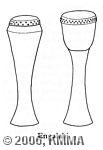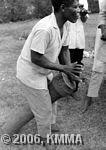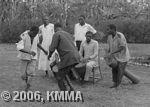





Other names: omugalabi, engaija, egaabi, omugudu, omugwabe.
The engalabi is a single-skin cylindrical drum measuring 90 to 120 cm in length and just 20 cm in diameter. The top and the bottom of the drum are of the same width, but the drum narrows in the middle and then gradually widens towards the ends. The engalabi drum is open at the bottom with a piece of hide stretched across; the hide is usually that of animals that live in the water or of the monitor lizard (varanus exanthematicus), but sometimes python or antelope skin is used. Because the engalabi is a single-skin drum, the skin is not laced but nailed down with wooden pins. These pins can either be nailed down in a single row or in a zigzagging double row and they penetrate deep into the wall of the instrument. On the outside they are secured until they hardly protrude from the cleaned skin. The engalabi is carried on the shoulder with a strap made of cow hide which is secured to the top and bottom of the drum through the holes specifically designed for that purpose. Some instruments are decorated by incising simple patterns all around the shell of the drum. If the wood splits, the crack is covered and reinforced with elephant hide (but nowadays more often with tin).
Like with the engoma, the inside of the engalabi drum is first removed and only then is the outside shaped. The engalabi can be hollowed out in two different ways: either the inside follows the contours of the outside of the shell or the inner walls are vertical and widen at the top. The latter is mainly found among the Kooki and the Tagwenda. The drum is placed in the sun or next to a fire before it is played to tighten the hide and so enrich the sound.
There are three ways of playing the engalabi: the drum is either clasped under the arm with a strap across the shoulder, or it is placed on the floor at a slant and clasped between the knees, or it is placed flat on the ground and held between the feet. In the first instance the player stands upright, in the second he bends over slightly and in the third he sits on his haunches. The drum is always struck with the hands and is almost always played by men; only among the Tagwenda do the women play the drum.
The engalabi drum is never played on its own but is always combined with other drums and rattles. It is, however, also used to accompany some melody instruments such as the royal flutes and horns. The engalabi is inextricably linked with the dance traditions, such as the ekizina among the Kunta, the entogoro among the Kooki and the Nyambo, and the ekitaaguriro among the Tagwenda.
The extraordinary polyrhythms of the engalabi resound together with the royal flute and horn ensembles at the royal court of the Omugabe and at festive occasions elsewhere in Ankole. The engalabi also used to be played during celebrations of the New Moon in the former kingdoms of Ankole and Buzimba.
for more information see also: VAN THIEL, Paul, "Multi-Tribal Music of Ankole. An ethnomusicological study including a glossary of musical terms." Edited by the Royal Museum for Central Africa, Annales, Sciences Humaines, nr 91, 1977, 234 pp.
© KMMA/Paul VAN THIEL